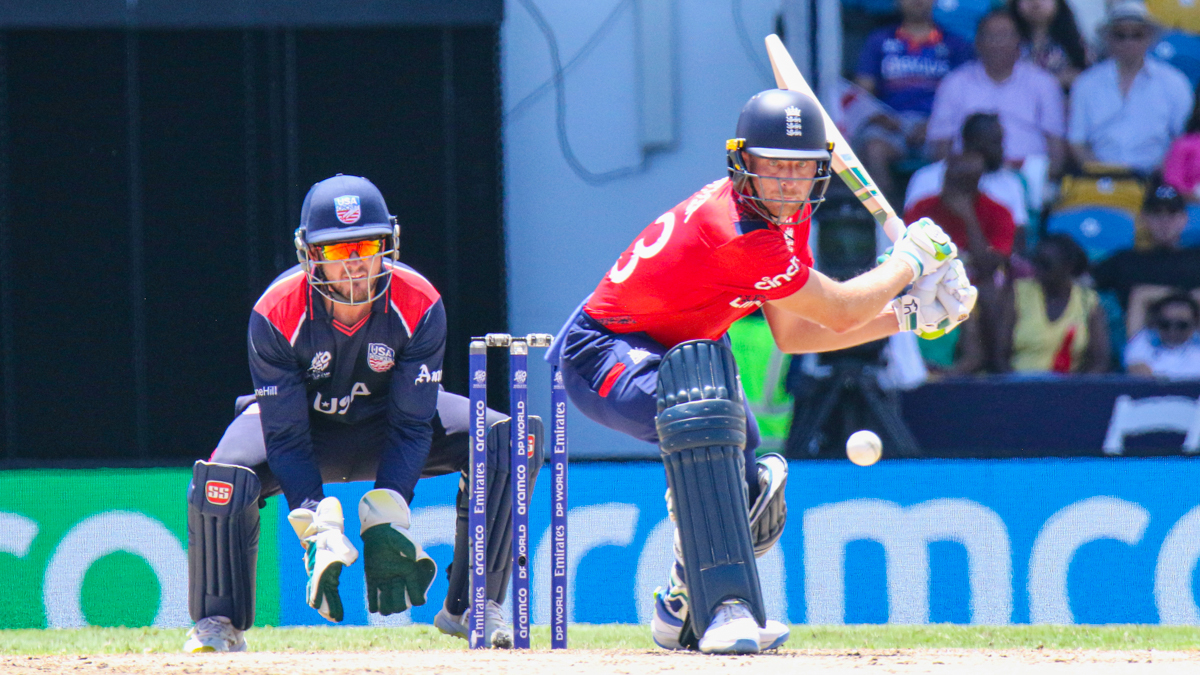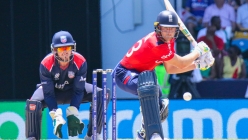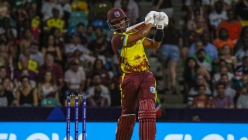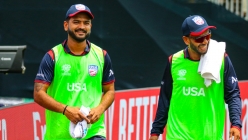Views
Spanking at the hands of England exposes the follies of USA Cricket’s unprofessional administration
2024 Jun 24 by DreamCricket USA

By Peter Della Penna in Bridgetown, Barbados (Twitter/X @PeterDellaPenna)The 2024 ICC Men’s T20 World Cup ride was fun while it lasted for USA. But the honeymoon is over. With the ICC AGM on the horizon in July, USA Cricket can run but they can’t hide.
Photo credit: Peter Della Penna
Before this T20 World Cup began, few people expected USA to advance beyond the group stage. Few people expected them to beat Pakistan. The mainstream media exposure generated after Saurabh Netravalkar’s Super Over heroics is unprecedented in modern American cricket history, something that the ICC and USA Cricket have never been able to do through any other initiatives. Taking undefeated semifinalists India and South Africa as deep as they did was something that showed USA belonged in the Super 8s and that their result over Pakistan wasn’t a fluke.
Which is why all of this makes USA’s Super 8 weekend in Barbados so disappointing. Two things can be true at once. Yes, USA can be proud to be the only Associate team to reach the Super 8s, that too in their first T20 World Cup appearance. They can be proud of the fact that they’ve secured a place in the 2026 T20 World Cup.
But all of the good things that were happening for USA in the early parts of the tournament served to paper over the cracks of longstanding issues that have been apparent well before the start of the World Cup and will continue to be a problem long after it has finished. Some of those things manifested themselves in plain sight during a nine-wicket thrashing at the hands of West Indies followed by a 10-wicket humiliation dished out less than 36 hours later by England.
At the top of the list is the selection of Nisarg Patel. A popular refrain from many rose-tinted glasses wearing fans after USA’s wins over Canada and Pakistan to start the tournament was that the wins validated USA’s squad selection prior to the tournament. No, they didn’t. It validated USA’s first choice starting XI to begin the tournament, not their 15-man squad selection. USA’s subsequent losses to West Indies and England highlighted that there is a massive difference between the two things. USA’s series against Bangladesh demonstrated that there was going to be little need for a third left-arm spinner in the team when even somebody as accomplished as Nosthush Kenjige wasn’t guaranteed a spot in the starting XI, let alone bowl a full quota of overs, based on the day-to-day batting matchups presented by the opposition.
Yet USA’s hard-headed administration persisted with maintaining Nisarg’s place in the team. Unsurprisingly, he was not picked to play in a single match at the T20 World Cup. At face value, this is not in and of itself an issue. After all, the only three teams to have all 15 squad members make at least one appearance in the tournament are New Zealand, Oman and Uganda, and more than half of the teams in the tournament had at least two players who never made it into the starting XI.
However, none of those other teams also had their captain get injured in such a comical manner after just two matches in the tournament. Monank Patel’s right shoulder injury, suffered in a now infamous post-match celebration on the team bus following their Super Over win over Pakistan on June 6, resulted in him missing the rest of the tournament. USA Cricket’s obfuscation of the events surrounding his injury and how it occurred – USA Cricket team management and administrators have repeatedly declined to discuss how exactly Monank injured himself – only made matters worse as it became apparent that the truth was a source of embarrassment befitting the reputation of American cricket shenanigans over the years.
Perhaps the worst part of Monank’s injury though was USA Cricket’s stubborn refusal to come to grips with reality and replace him in the squad. There have been theories floating around as to the reasons why. One is that there was a misguided belief that Monank’s injury wasn’t as bad as first thought and they felt that it was worth waiting out a few games if he could make it back by the end of the tournament, which obviously didn’t happen. Another is that there were no decent replacements worth flying in, something that Gajanand Singh supporters would highly dispute.
But the most plausible explanation for why Monank was never replaced in the squad and instead got a free vacation to Barbados on the ICC’s dime is that USA Cricket are a notorious bunch of penny-pinching cheapskates and didn’t want to have to foot the bill to fly in a 16th player into the squad. After all, it was less than two months ago that there was a near mutiny in the World Cup squad over a pay dispute when USA Cricket initially handed them a low-ball contract offer of $250 per match fee for the T20 World Cup.
Returning to the issue of Nisarg and Monank, it was the injury to the latter which disrupted USA’s squad balance and underscored the problem with selecting the former. Tour management’s completely understandable position to not select Nisarg for any matches effectively meant that USA was selecting from a 13-man squad for the final five matches. With each successive loss, more question marks were raised but there was no easy way to find an answer when only two options were available on the bench instead of four. Would one or two replacement players for Nisarg and an injured Monank have made a difference for USA in their losses to India, South Africa, West Indies and England and turned any of those results into wins? Maybe, maybe not. There’s no way of knowing, but it would have been nice to find out.
That one of USA’s two remaining (or four potential) options was not a legspinner has also been discussed at length but is worth revisiting again. Adil Rashid’s Player of the Match performance for England against USA hammered home the point about the impact a wristspinner can have in T20 cricket. USA has a couple in the pipeline in Yasir Mohammad and Zia Shahzad. Mohammad might have fallen back since his USA debut against Ireland in 2021, but it’s hard to tell in some ways because of his lack of opportunities as a consequence of USA’s outdated selection philosophy as well as USA Cricket making no effort to schedule any T20Is between July 2022 and April 2024. Shahzad was in much better domestic form in the leadup to the T20 World Cup, and is also an outstanding fielder, but both leggies were passed over because various influential figures in American cricket were adamant that Nisarg be in the squad come hell or high water.
The questions go beyond these political reasons though and once again stretch into a repeatedly disproven myth that players with international experience from Full Member nations are borderline infallible when compared to USA’s homegrown talent. USA has been down this path more times than it cares to remember with the likes of Jermaine Lawson, Xavier Marshall, Neil McGarrell, Hamish Anthony, Rusty Theron and others. Corey Anderson has turned out to be a slightly shinier example. As was the case with all prior examples, a major reason why said player is available to play for USA is because they are well past their prime and if you were getting the version of themselves when they were at their peak, they’d still be playing for their original country instead of trying to break into the USA setup.
USA fans imagined they were going to get the 2014 version of 23-year-old Anderson who terrorized West Indies with a record-setting New Year’s Day century in Queenstown. In other words, the vision that USA fans thought they were going to get out of Anderson is the display that England captain Jos Buttler put on by smashing five sixes in a row off Harmeet Singh, which itself was a not so subtle message about where Major League Cricket and it’s 2023 No. 1 overall draft pick stands in the global T20 franchise pecking order in relation to The Hundred. Instead, the 33-year-old version of Anderson USA fans got was seeing him scratch around for 7 off 15 balls against West Indies and 29 off 28 balls against England. A solitary glimpse of vintage Anderson came when he reverse swept Liam Livingstone for six against England, but it was a fleeting moment, his only boundary of the weekend and one of just four he hit across the tournament.
Anderson’s tournament stats read as such: 66 runs off 72 balls, a best of 29, an average of 16.50, and a strike rate of 91.66. Bowling wise, his surgically repaired back does not allow him to come anywhere close to clocking above 140 kph like he did in his prime. He took a wicket with his first ball of the tournament against Canada, and then nothing after to finish with an average of 69.00 and an 8.62 economy across eight overs. Asked how he would describe his performance in the tournament following the loss to England, Anderson’s own word was “lackluster.” Was his output disappointing? Yes. Considering the mountain of prior evidence of players that have had T20I and ODI careers for other countries who then try to suit up with USA for one last hurrah, should it have been surprising? No.
Yet every subsequent generation of USA administrators seem to have never learned the lessons and mistakes made by their predecessors. When selection Option A is an experienced player in their mid 30s with X number of international matches in country Y, and Option B is a homegrown player from California, New Jersey, Texas or another state who has shown promise domestically but hasn’t gotten a chance to prove himself by playing in a Test nation, selection Option A has been the conservative route USA selectors have always pursued. Conservative, cautious, but not necessarily safe. Because time and again it rarely if ever works.
As is the case with the refusal to pick a legspinner, USA’s selection philosophy has forever been risk-averse when considering untested homegrown talents against experienced former overseas pros. Having said that, the performance of Florida-born and raised Steven Taylor in this tournament is a handy counter-argument that makes it harder for Option B to be pursued in the future. USA’s all-time leading scorer – more so for accumulative longevity rather than sustained brilliance – had a worse tournament than Anderson: 74 off 82 balls with a best of 24, an average of 12.33 and a strike rate of 90.24.
Taylor’s weekend performance in Barbados is a microcosm of his entire career. Coming off of back-to-back 24s against India and South Africa, he looked like he was on the cusp of hitting his stride and finally producing an innings of substance. Instead, he poked around for 2 off 7 and 12 off 13 before getting out in the same way he has been dismissed more than any other in his entire career: a cut into the hands of backward point.
At least Taylor can console himself with a significant silver lining: his one-handed catch in the slips against Pakistan for the first wicket to kickstart a famous day. It’s hard to find one for Anderson, who never faced a ball in that match, something that came under heavy criticism at the time from various sections of the media in the moment – including from this journalist – but which in hindsight looks like a stroke of genius on the part of USA head coach Stuart Law.
Looking elsewhere in the squad, overwhelming early highs were followed by underwhelming finishing lows. Saurabh Netravalkar became USA’s most recognizable player by the time they left American shores for the Caribbean, turning into a folk hero not only for his heroics against Pakistan, but by taking the wickets of Virat Kohli and Rohit Sharma against India. But Netravalkar’s wicketless returns against West Indies and England poured cold water on the notion that he is in line for an IPL contract.
Fellow new ball bowler Ali Khan, USA’s longtime fixture on the T20 franchise circuit, had his face plastered all over tournament advertising and he was included in other T20 World Cup promotional activities, such as lighting up the Empire State Building with Chris Gayle and being included in the Sean Paul & Kes music video for the official song for the 2024 Men’s T20 World Cup, “Out of This World”. Khan fared well in the group stage, taking three wickets including a best spell of 1 for 21 in 3.2 overs against India. But his Super 8s output fell well short of headliner status, going wicketless in his last three matches to end the tournament with an average of 60.33 and a 9.36 economy. Khan’s lack of wickets in the second phase of the tournament were all the more noticeable after England’s Chris Jordan took a hat-trick – which started with the wicket of Khan – and 4 in 5 balls to wipe out the USA tail on Sunday morning.
Aaron Jones had also turned into something of a household name following his once in a lifetime performance against Canada and a handy encore against Pakistan, both in the final seven overs of regulation as well as in the Super Over. But just like Jaskaran Malhotra’s career trajectory ever since his six sixes in an over against Papua New Guinea, Jones’ deal with the devil expired very quickly based on his returns over his last four innings: 11 off 22 balls, 0 off 5, 11 off 11 and 10 off 16. Jones rapidly went from Flash Gordon to flash in the pan, and the old discussions about his role in USA’s T20I lineup came roaring back by the end of the Super 8s.
Perhaps the only player who was consistently solid from beginning to end was Andries Gous, who at one point during the West Indies match sat atop the tournament run charts and ended with 219 runs at an average of 43.80 plus a strike rate of 151.03 to go along with two fifties. The fact that Gous and Jones were the only players to cross 100 runs in the tournament for USA underscored how much they leaned on Gous, not only for his runs but also to take over the gloves behind the stumps once Monank was injured.
As the smoke begins to clear on USA’s T20 World Cup journey, several other questions remain. First and foremost, how many of these players will stick around going forward? USA Cricket’s negotiating tactics before the World Cup left a sour taste in the mouth of many players who may turn around and give USA Cricket the middle finger when it comes time to tour Netherlands in August to kick off the next cycle of Cricket World Cup League Two. How can USA maintain momentum from the T20 World Cup journey and retain new fan and media interest from the World Cup if some of USA’s leading faces don’t want to remain in the picture?
Bigger than that, will USA Cricket be suspended by the ICC? Prior to the T20 World Cup, many people were setting a countdown on their calendars and clocks to beep on July 22. That’s the final day of the ICC’s Annual General Meeting in Sri Lanka. Prior to the World Cup, most people were expecting USA Cricket to be suspended by the ICC for repeated governance issues – USA currently has no CEO and saw two key administrators resign in the leadup to the World Cup – after the ICC had already stripped USA Cricket of any administrative involvement in organizing the T20 World Cup, instead tasking a newly formed LLC called T20 World Cup USA to help Cricket West Indies with event logistics.
Amid the euphoria of USA’s win over Pakistan and progression to the Super 8s, USA Cricket’s administrative problems were temporarily memory-holed by a significant portion of the cricket community. West Indies and England subsequently gave USA a reality check to not only end USA’s tournament, but force the community to confront issues that they’ve tried to stall and ignore.
USA’s infrastructure is inadequate, highlighted by the fact that the ICC saw no reason to make Nassau County International Cricket Stadium a permanent venue to leave behind for the host country to continue using instead of a temporary vanity project that they could cash in on for 12 days without needing to worry about any maintenance upkeep afterward. The three washouts in Florida drew justified criticism over a combination of substandard drainage and insufficient equipment such as Super Soppers and tarp covers to deal with wet conditions which occur in Florida during Hurricane season stretching annually from June through November. These problems have always existed at Broward County Stadium ever since it opened in 2008 and are no stranger to anyone who has ever attended a US domestic event that has been washed out at the facility. But it became magnified 100-fold under the microscope of a T20 World Cup.
New fans and media were happy to jump on the bandwagon after they found out USA defeated Pakistan. Will they be as interested in following USA’s progress on an away tour to Namibia? Where are the kids who have started playing cricket as a result of this World Cup? The ICC organized some Criiio introductory cricket sessions during the World Cup in Texas, New York and Florida. But will any of those be converted into sustainable long-term community programs now that the World Cup carnival tents have packed up and left town?
Then there is the issue of funding. USA Cricket struggled mightily to secure sponsorships prior to the World Cup, eventually settling on Amul Dairy to be their solitary partner. In the wake of their win over Pakistan, they have been unable to capitalize on a golden opportunity that fell into their lap, failing to secure any sponsorships going forward now that the Amul Dairy deal has finished with the conclusion of USA’s participation in the T20 World Cup.
A sales pitch of, “How would you like to support the USA national team by seeing your brand logo splashed on a Team USA jersey in a home World Cup that will be seen by a global TV audience of more than a billion people?” seemed like a slam dunk proposition on a five-foot high basketball hoop instead of the regulation 10 feet off the ground. Yet USA Cricket managed to bungle the opportunity off the back of the rim before the World Cup, then was gifted a rebound right under the basket by Pakistan only to clang the iron again.
The 2024 ICC Men’s T20 World Cup ride was fun while it lasted for USA. But the honeymoon is over. With the ICC AGM on the horizon, USA Cricket can run but they can’t hide.




